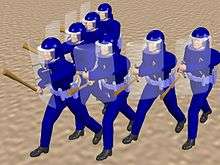Pickaxe
 Pickaxe on the ground | |
| Other names | Pick, pickax |
|---|---|
| Classification | Digging tool |
| Types | Railroad pick, miner's pick |
| Related | Mattock |
A pickaxe or pick is a hand tool with a hard head attached perpendicular to the handle.
Some people make the distinction that a pickaxe has a head with a pointed end and a blunt end, and a pick has both ends pointed, or only one end; but the international Oxford Dictionary of English states that both words mean the same, i.e. a tool with a long handle at right angles to a curved iron or steel bar with a point at one end and a chisel or point at the other, used for breaking up hard ground or rock.[1]
The head is usually made of metal, and the handle is most commonly wood, metal or fiberglass. The head is a spike ending in a sharp point, may curve slightly, and often has a counter-weight to improve ease of use. The stronger the spike, the more effectively the tool can pierce the surface. Rocking the embedded spike about and removing it can then break up the surface.
The counterweight nowadays is nearly always a second spike, often with a flat end for prying.
The pointed edge is most often used to break up rocky surfaces or other hard surfaces such as concrete or hardened dried earth. The large momentum of a heavy pickaxe on a small contact area makes it very effective for this purpose. The chiseled end, if present, is used for purposes including cutting through roots.
A mandrill (among other meanings, see Mandrill (disambiguation)) is a miner's smallish pick for use in confined spaces.
Originally used as agricultural tools as far back as prehistoric cultures, picks have also served for tasks ranging from traditional mining to warfare. The design has also evolved into other tools such as the plough and the mattock. In prehistoric times a large shed deer antler from a suitable species (e.g. red deer) was often cut down to its shaft and its lowest tine and used as a one-pointed pick,[2] and with it sometimes a large animal's shoulder blade as a crude shovel. During war in medieval times, the pickaxe was used as a weapon.
Unicode 5.2 in the Miscellaneous Symbols block introduces the glyph ⛏ (U+26CF PICK), representable in HTML as ⛏ or ⛏, to represent this tool.
Pickaxe handle

A pickaxe handle (sometimes called a "pickhandle" or "pick helve") without the head is sometimes used, often unofficially, as a baton: for example it is officially sometimes used as a baton in the British Army.
A pickaxe handle has been known to be used while scuba diving to fend off sharks by jabbing them bluntly on the nose.
In The Grapes of Wrath by John Steinbeck, pick handles featured prominently as a weapon used against the migrant farmers.
A normal pickaxe handle is made of ash or hickory wood and is about three feet long and weighs about 2.5 pounds. British Army pickaxe handles must, by regulation, be exactly three feet long, for use in measuring in the field. New variant designs are:
- With a plastic casing on the thick end.
- Made of carbon fibre
In former times they were sometimes made with a steel casing on the thick end.
See also
| Wikimedia Commons has media related to pickaxes. |
References
- ↑ Soanes, Catherine and Stevenson, Angus (ed.) (2005). Oxford Dictionary of English, 2nd Ed., revised, Oxford University Press, Oxford, New York, p. 1330, ISBN 978-0-19-861057-1.
- ↑ "Deer-antler pick, used in flint mining from Grimes Graves". ingenious.org.uk. Retrieved 6 July 2012.
| ||||||||||||||||||||||||||||||||||||||